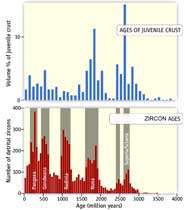Bias in the rock record?

(PhysOrg.com) -- The fossil record is known to be biased by the unevenness of geographical and stratigraphical sampling, and the lack of exposed rocks containing fossils. In a recent Perspective in Science [2 January 2009] Professor Chris Hawkesworth from the University of Bristol and colleagues suggest that a similar unevenness biases the record of the evolution of the continental crust.
Rocks of the continental crust are dated using zircons, an extremely durable mineral that forms during the generation of granitic rocks. Some granites represent the formation of new continental crust and the zircons eroded out of these can persist for billions of years in sedimentary deposits. Other granites are generated from the melting of continental crust formed from such deposits. The age of that pre-existing crust can still be determined from the zircons, and the oldest zircon ever found is from such ancient sediments. It is 4.4 billion years old, only 150 million years younger than the planet itself.
It has long been known that the ages of rocks which form the continents are constrained to several peaks throughout Earth's history, but why this should be is open to question. The debate has previously focused on the likelihood that these peaks are related to deep-seated thermal anomalies within the Earth, resulting in so-called ‘superplumes’ which lead to periods of accelerated magmatism and the growth of continental crust.
More recently, the debate has turned to the potential correlation of peaks of continental magmatism with the periodic formation of ‘supercontinents’, such as Pangea and Gondwanaland. It is not clear, however, why the development of supercontinents should be associated with the generation of unusual volumes of igneous rocks. What seems more likely is that the age peaks in the continental rock record reflect a bias in preservation during periods of supercontinent formation where magmatism and crustal growth have an enhanced chance of preservation, because they are protected within the enveloping supercontinent.
In between periods of supercontinent formation, continuous magmatism at plate margins such as the Pacific ‘Ring of Fire’ where oceans are subducted beneath the continents, appears to have a much lower preservation potential, since crust along subduction zones is destroyed as fast as it is made.
Hawkesworth and his colleagues argue, therefore, that the age peaks within the continental crust are largely a bias related to preservation, or the lack of it, and that this needs to be taken into account when using the continental crust as a probe for the geodynamic evolution of the Earth. One implication is that at least since the Archaean (2.5 billion years ago) Earth geodynamics have been relatively uniformitarian.
The paper: A Matter of Preservation. Chris Hawkesworth, Peter Cawood, Tony Kemp, Craig Storey, Bruno Dhuime. Science, 2 January 2009: Vol. 323. no. 5910, pp. 49 - 50. DOI: 10.1126/science.1168549
Provided by University of Bristol




















